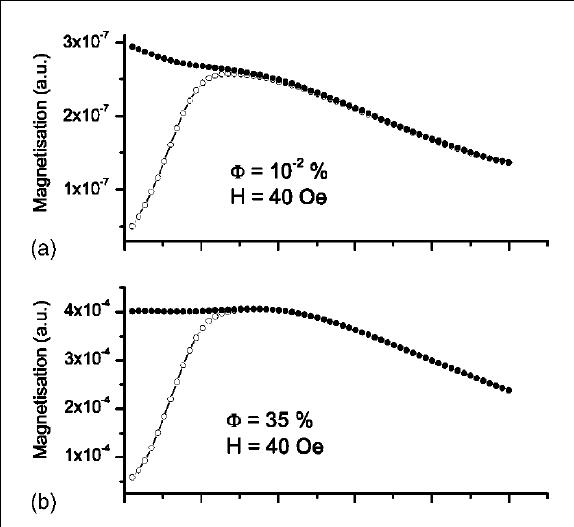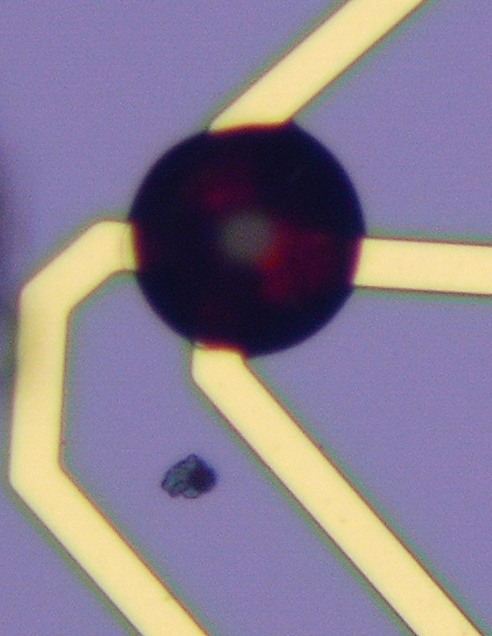Cooperation, Competition and Frustration
PERPETUALLY UNDER CONSTRUCTION
Interacting magnetic (single-domain) nanoparticles
Single domained ferro- or ferri-magnetic nanoparticles with unique anistropy axis (easy-magnetization axis) are superparamagnetic (SPM) in the absence of inter-particle interactions. That is, the magnetic moment of a particle can fluctuate randomly by thermal fluctuations at high enough temperatures, just as an atomic spin in a paramagnetic material. At low temperatures, the thermal energy becomes smaller than the anisotropy barrier energy inducing particles' magnetic moments to be blocked in the direction of the easy-magnetization axis. This blocking of magnetic moments occur at the temperature TB determined by the particle's size and its composition.
When nanoparticles are sufficiently close to one another, the random, long-range dipole-dipole interactions create a collective phase at low temperatures. Such concentrated nanoparticle assemblies can be made into regular crystal lattice or in a completely random configuration when dispersed in fluid media such as water, oil, or glycerol. In these systems, the dipole-dipole interaction energy added to the individual partciles' anisotropy energy pushes the 'blocking' temperature higher. In some cases of concentrated, monodisperse nanoparticles in frozen media (called ferrofluids) a magnetic state of Superspin Glass has been witnessed. This state is analogous to atomic spin glass states in which the randomness of spin interactions create frustration among them such that a true ground state can never be reached. The name 'superspin' has its origin in the individual nanoparticle's large magnetic moment (e.g. 104 μB per particle of γ-Fe2O3 with 8.6nm diameter). Emblematic sign of spin-glass behavior such as the critical slow down near transition temperature as well as the aging and memory effects (although small) have been observed in frozen ferrofluids.
In our group, we have focused our research effort on the Out-of-Equilibrium dynamics in the superspin glass state of concentrated maghemite ferrofluids. More specifically, we have examined the aging behavior through the thermoremanant magnetization, the AC susceptibility relaxation and zero-field cooled magnetization measurements through which the growing number of correlated superspins has been extracted. Recently, we have investigated the effect of textruization (the anisotropy axis alignment) on the aging dynamics of ferrofluid superspin glass. These experimental studies were conducted using a bulk SQUID magnetometer (CRYOGENIC(TM) S600).

Superspin Glass – up close and personal
In the past few years, a novel, experimental approach is being developed in our group to investigate the out-of-equilibirum dymamics of ferrofluid's superspin glass state at mesoscopic scale. based on micro-Hall probes. The Hall-probe magnetic field sensors are made of d-doped pseudomorphic heterostructure [4] are fabricated by ITRON France (V. Mosser, A. Kerlain) and by LSI (Laboratoire des Solides Irradiés, CEA/IRAMIS). We have improved the signall-to-noise quality of these sensors via Spinning Current Technique. Our measured magnetic field resolution is only a few mG/Hz1/2 which enables us to measure not only the local magnetic field change arising from a ~pico-liter of ferrofluid sample (see Figure 2), but also the fluctuations of the magnetic susceptibility of the sample. More details on the Hall sensors will be available shortly on our 'techniques' page.
Due to its extreme sensitivity to the local magnetic field change and its proximity to the magnetic samples, micro-Hall sensors are ideal tools to explore the dynamic magnetic behavior at meso and macroscopic scales. Our research projects include:
- Violation of Fluctuation-Dissipation Theorem through the magnetic noise measurements (published)
- Step-wise magnetization effects (current project)
- Magnetization reversal in single magnetic nano-objects (future)

Other nanostructured magnetic systems
We are also interested in other types of nano-structure magnetic objects and the emerging magnetic phenomena associated to their shapes and spatial configurations. On going projects include:
- 3D supercrystals of magnetic nanoparticles – beyond superspin glass (in search of super-ferromagnetism/antiferromagnetism via dipole interactions)
- Nanopillars – magnetization reversal detection (collaboration with M. Konczykowski and T. Wade, LSI)
Images from our Lab
|
|
|
|
|
From left to right: Hall sensor with Schottky gate. Right panel: scheme of sample electrodeposited on the top of Hall sensor (courtesy of V. Mosser, ITRON FRANCE), Experimental apparatus for micro-Hall probe measurements, Reduction of the ferrofluid micro-drop sizes from 25 microns to 4microns, an image of a nickel nanowire (courtesy of T. Wade, Ecole Polytechnique).
Recent publications related to these subjects
-
On Superspin glass and out of equilibrium dynamics
- K. Komatsu, D. L’Hôte, S. Nakamae, V. Mosser, M. Konczykowski, E. Dubois, V. Dupuis, R. Perzynski, “Experimental Evidence of Violation of Fluctuation-Dissipation Theorem in a Superspin Glass”, Physical Review Letters 106 150603 [2011].
- S. Nakamae, C. Crauste-Thibierge, K. Komatsu, D. L’Hôte, E.Vincent, E. Dubois, V. Dupuis and R. Perzynski, “Anisotropy-axis orientation effect on the magnetization of g-Fe2O3 frozen ferrofluid” Journal of Physics D: Applied Physics 43 474001 [2010].
- Observation of superspin glass state in magnetically textured ferrofluid (γ-Fe2O3)
- Growth of a dynamical correlation length in an aging superspin glass
-
On Micro-Hall sensor technique
- K. Komatsu, D. L’Hôte, S. Nakamae, F. Ladieu, V. Mosser, A. Kerlain, M. Konczykowski, E. Dubois, V. Dupuis, R. Perzynski “Noise Measurement of Interacting Ferromagnetic Particles with High Resolution Hall Microprobes” AIP Conf. Proc. 1129, 153 [2009].





